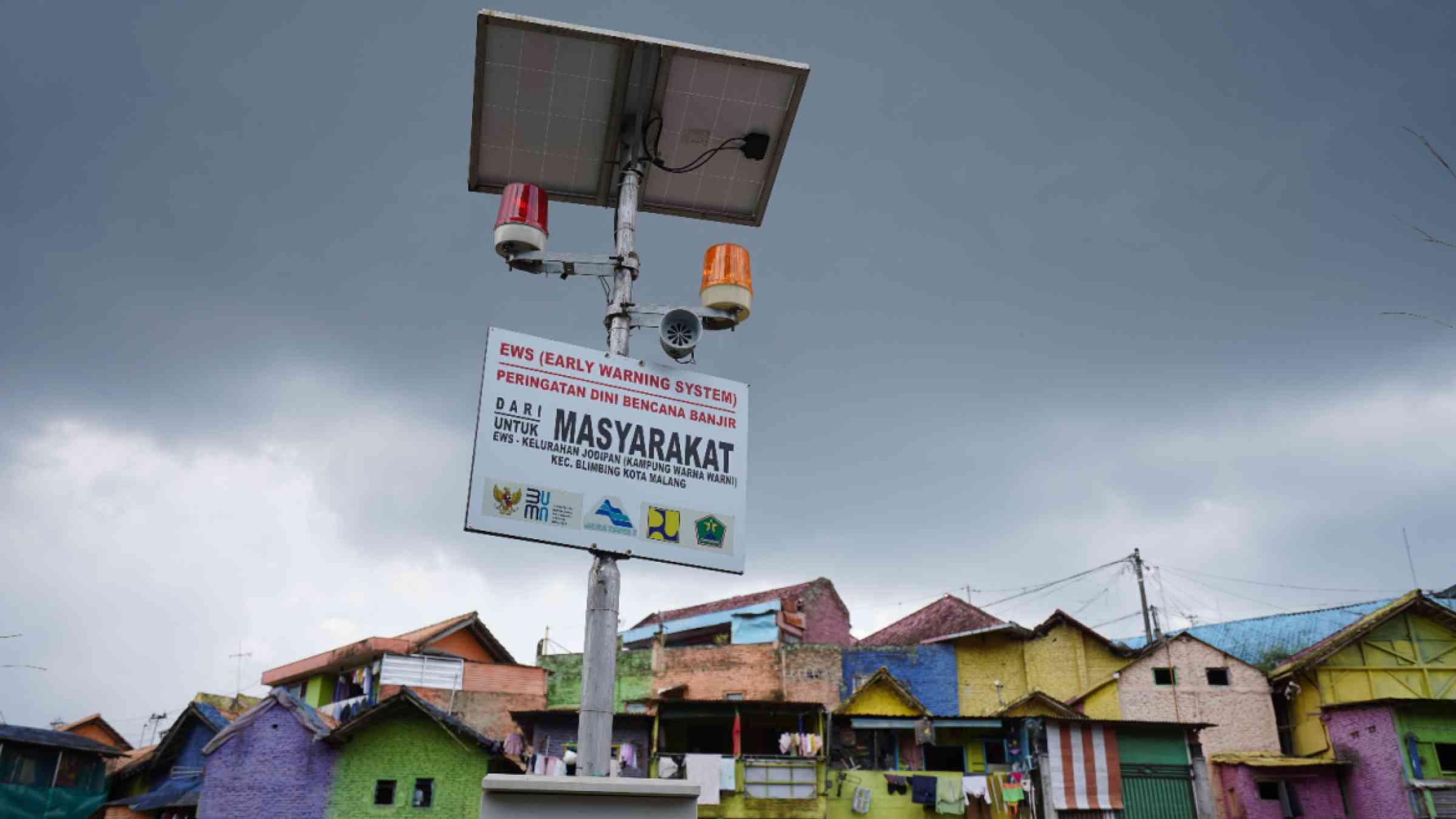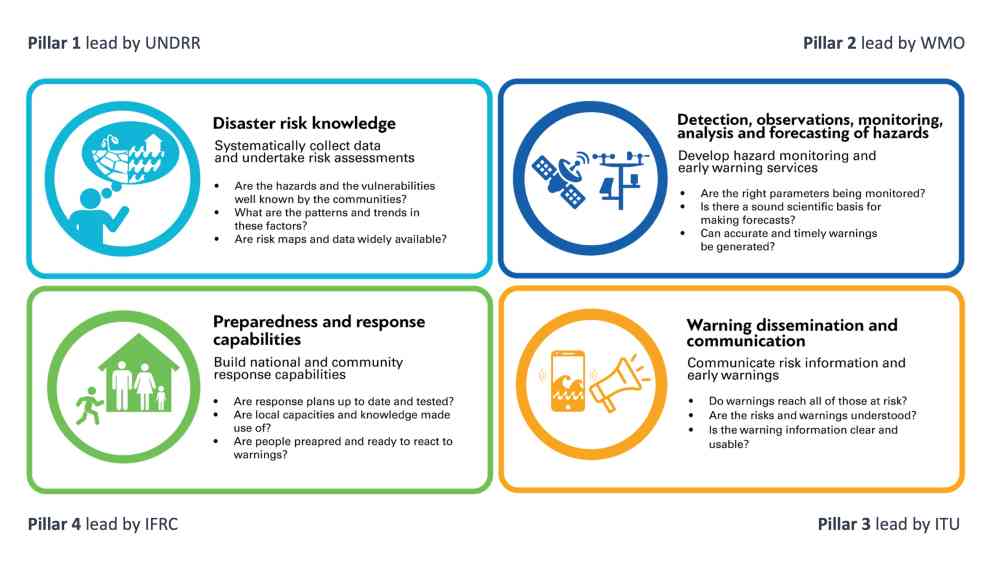Strengthening equitable, impact-based early warning through artificial intelligence: four key perspectives

In today's rapidly advancing technological landscape, understanding the opportunities and challenges of achieving equity in multi-hazard impact-based forecast and warning service through artificial intelligence (AI) is critical to ensuring that services benefit all.
High-level commitments and projects under the Early Warnings for All Initiative (EW4All) support the development of early warning systems (EWS) (WMO, 2022). There is an ongoing discussion on how to put people at the centre across the four pillars of early warning (Picture 1). A leading innovation is the development of impact-based early warning systems that transition from knowing what the weather will be to what the weather will do.
View updates from the Early Warnings for All Initiative.

Picture 1: Four Pillars of the EW4ALL initiative
Drawing on insights from a session on AI and EWS during the AI & Climate Expert Meeting organized by the United Nations University (UNU-EHS) in July 2024, this perspective aims to reflect on the question of whether, and how, AI can be a tool to support impact-based early warning in:
- understanding risks linked to climate extremes in their complexity;
- accelerating monitoring and observation;
- leveraging the accessibility of warning information;
- contributing to existing response efforts on the ground.
In doing so, we explore the challenges and risks of introducing artificial intelligence across the four pillars of early warning.
1. Disaster risk knowledge: advancing vulnerability and exposure information through AI
Impact-based forecasts and early warnings (IbEWS) advance disaster risk knowledge to move beyond hazard information towards integrating vulnerability and exposure into operational warning chains. For example, they not only inform people about drought severity levels but also monitor the potential impacts on people's livelihoods that depend on the agricultural sector. This can help response agencies anticipate the actions needed to prevent the effects, such as food insecurities or economic losses, ahead of time.
The session has highlighted the potential for advancing vulnerability and exposure information to inform impact-based early warning through AI.
- First, AI can help collect high-resolution, granular and dynamic vulnerability and exposure data to fill gaps in data-scarce regions. For, example, AI can support in Earth Observation to identify accessible roads during disasters such as floods.
- Secondly, AI could be used to transfer and compare risk assessments to similar instances. This use, however, should be treated with the utmost care as case-specific contexts are critical for understanding risk.
- Third, AI has the potential to support the analysis of large amounts of data, which could - if the data is reliable and accurate- aid in making risk-informed decisions in urgent and rapidly changing risk scenarios.
"One of our challenges will be about bringing this innovation to the people it is actually going to serve"
- Karen Dall, German Red Cross
However, automated tools are mainly fed into the data-driven components of IbEWS. While the tools do have potential to fill data gaps, it is necessary to ensure that vulnerability and exposure information are co-produced through community exchange in a hybrid manner.
Multiple challenges persist in making co-production inclusive and equitable, notably for vulnerable communities.
View more resources on AI in DRR.
"Are these issues specific for the AI-supported EWS system? I would say not exclusively and entirely because other early warning systems also have similar issues"
- Prof. Markus Reichstein, Max-Planck-Institute for Biogeochemistry
Understanding that AI is merely one additional tool that can advance certain parts of the IbEWS chain can emphasize other approaches for designing inclusive, accessible early warning systems at the community level.
2. Monitoring, evaluation and observation: accelerating data availability and analysis
One operational example of data availability - among many - is the WMO Severe Weather Information Center 3.0 (SWIC 3.0). This platform disseminates severe weather alerts and information from WMO members, and consolidates data on extreme weather, tropical cyclones, and other severe weather observations to support a global multi-hazard alert system.
AI can significantly enhance this by introducing predictive analytics and real-time decision-making capabilities.
"AI can in the future simulate various weather scenarios and systemic risks associated with them."
- Dr. Muhibuddin Usamah (WMO)
AI has already been explored in different applications in the context of EWS. It is expected to further accelerate the detection of subtle patterns that indicate the early stages of impending hazards such as floods and droughts. AI's ability to collect, process and interpret vast amounts of data from various sources - such as satellite imagery or weather stations - can enable continuous and comprehensive impact forecasts in dynamic and high-resolution.
However, AI applications might replicate existing data biases and gaps, leading to inequitable outcomes for those who are underrepresented. For example, automated AI tools might overlook marginalized communitieswhen processing and analysing large amounts of information when the data does not reflect minority groups sufficiently. Similarly, traditional and local early warning signs, often absent from current datasets, can be left unnoticed. View more resources on those challenges of AI and humanitarian action.
Furthermore, the significant data investments for integrating AI-supported models in operational chains might not be sustainable and maintainable for the existing regional, government, and user resources.
Many of the contexts in which IbEWS are urgently needed are precisely those contexts which are data scarce.
AI is both an opportunity and a challenge. It is an opportunity as AI might be able to fill data gaps, e.g. through the use of Earth Observation data. At the same time, it is a challenge as AI needs large data sets to be trained and if there is only little data available this has significant impacts on the generated outputs.
3. Dissemination and communication: Leveraging accessibility
Communities in South Asia have already benefited from advanced warning communication through AI. An example is the automated seasonal impact-based forecasting tool developed by UN ESCAP.
AI-enabled systems are, for example, optimizing alert dissemination through tailored messaging across multiple channels, to ensure that warning information reaches diverse populations effectively. Translating warning messages in various languages and providing barrier-free communication channels can also be advanced through AI. For example, automated and customized text alerts can be tailored to end-users, and user reports from social media can be integrated into situational awareness updates.
Unlocking communication formats using AI in early warning systems comes with challenges, such as a lack of trust in AI-generated information.
If information is perceived to be unreliable, and early warning system performance is patchy, the community's trust in the warnings can break down, with devastating consequences.
Operational processes must be put in place to manually screen and validate the vast amounts of data collected and processed by AI - but this can be a monumental challenge. False information generated by AI might be overlooked due to the lack of capacity at the local level, for example, which can have fatal consequences in the context of early warning.
It is therefore essential to build adequate capacity to ensure the inclusivity of the use of AI for early warning systems - at local as well as national and regional levels.[3] [4]
4. Response capacities and preparedness: Reaching the first mile
Experts at the Red Cross are considering AI's potential for simulating various emergencies. Such exercises could benefit humanitarian practitioners in developing and refining contingency plans and allocating resources in the future. The practice could also provide up-to-date situational awareness to response agencies.
"How we can bring people together. What is feasible on the technological side and what is feasible on the ground"
- Karen Dall, German Red Cross
Karen Dall, of the German Red Cross, highlights that participation at the community level is essential for making EWS actionable and inclusive.
A pressing challenge is to include community experts and diverse perspectives in the co-creation of IbEWS, notably when integrated AI tools are used. Existing inequalities of access and decision-making of IbEWS could be amplified if AI tools are designed, run, and owned without end-users and receivers at the local level.
This becomes even more pressing in the context of AI applications for IbEWS: For inclusive and equitable systems, we need to ask whether it is meaningful for people at the right moment in time and whether it has content that transfers into actions at the local level. While in existing systems, this is already a challenge; automated models may narrow this people-centric interaction along the warning chain even more.
Practical action for the future
Putting people first is key for equitable design and inclusive implementation of IbEWS. AI applications can not be presented as a panacea for achieving equity in IbEWS and beyond.
Pre-existing inequalities, such as the digital divide and underrepresentation of people or specific groups (e.g. minorities), must be addressed carefully to avoid amplifying power dynamics through automated tools. In doing so, experts highlight the relevance of creating a sustainable and people-centred approach to AI.
These are the critical actions that can help to advance equitable EWS through AI:
- Prioritise community involvement: Engage diverse community and response agencies in co-creating AI and its use for supporting multi-hazard impact-based forecast and warning service. This ensures that services are equitable, inclusive and tailored to the needs of those most at risk.
- Enable exchange between actors in the warning chain: Facilitate a space for interdisciplinary knowledge exchange between different perspectives, such as humanitarian actors and technological experts, to explore the merits and pitfalls of AI in existing operational warning chains. Addressing the gap of unprecedented collaboration between actors, including communication between the AI technical community, humanitarian organisations and communities, is critical to guide the ethical use of AI in EWS.
- Create good practice examples and resources: Synergies and capacity building can enhance the development of value-based AI applications in the context of EWS and foster learning as a continuous process at global, regional and local level.
- Promote ethical AI practices: Establish or promote existing guidelines and frameworks to ensure AI applications in EWS adhere to ethical standards, protecting the rights and privacy of communities and individuals. This includes transparent algorithms, address biases, and accountability measures to build trust and reliability in AI-driven EW.
The global initiative of the Early Warnings for All (EW4All) aims to achieve global coverage of early warning systems by 2027. This blog is based on the expert discussions at the Climate and AI Expert Meeting in Bonn, Germany.
Samira Pfeiffer, Dr. Maria Dewi, Dr. Saskia E. Werners, Dr. Himanshu Shekhar, Dr. Michael Hagenlocher are researchers in the Vulnerability Assessment, Risk Management and Adaptive Planning (VARMAP) division of the United Nations University - Institute for Environment and Human Security (UNU-EHS), Karen Dall is an anticipatory action specialist at the German Red Cross. Prof. Dr. Markus Reichstein is Director of the Biogeochemical Integration Department at the Max-Planck-Institute for Biogeochemistry. Dr. Muhibuddin Usamah is a Scientific Officer working on disaster risk reduction and multi-hazard early-warning systems at the World Meteorological Organization (WMO).
Editors' recommendations
- Early warnings for all: Executive action plan 2023-2027
- Designing inclusive, accessible early warning systems: Good practices and entry points
- Early warning of complex climate risk with integrated artificial intelligence
- Harnessing the potential of artificial intelligence for humanitarian action: Opportunities and risks